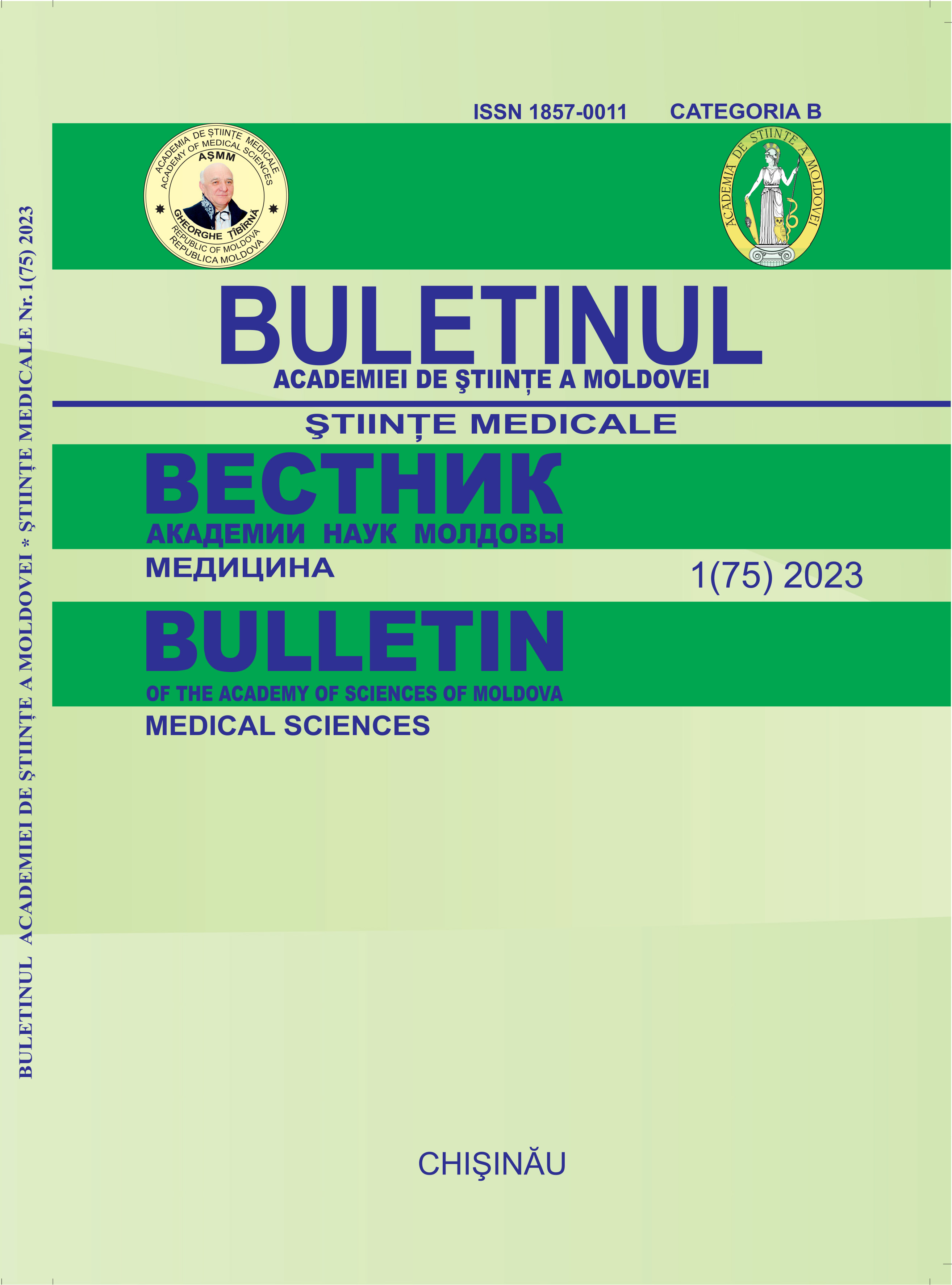Endothelial dysfunction in patients with non-ST-segment elevation myocardial infarction
DOI:
https://doi.org/10.52692/1857-0011.2023.1-75.06Keywords:
endothelial dysfunction, non-ST-segment elevation myocardial infarction, EndoPat 2000Abstract
Purpose: Evaluation of peripheral endothelial function using EndoPAT 2000 device in patients with non-ST-eleva-tion myocardial infarction (NSTEMI) and correlation with clinical characteristics of the patients.Material and methods: The study included 39 patients with NSTEMI, hospitalized in 2 PCI centers, in the period 03.2022-03.2023. At 72 hours after admission, peripheral endothelial function was assessed using the EndoPAT 2000 device. Patients were divided into 2 groups according to the presence of peripheral endothelial dysfunction (RHI <1.67). Statistical analysis of the data was performed using the t-test and the χ2 test. Results: The average value of the reactive hyperemia index (RHI) was 1.73 ± 0.47. Endothelial dysfunction was diag- nosed in 51,3% of NSTEMI patients. Group I included 19 patients with normal endothelial function (RHI>1.67), and group II – 20 patients with endothelial dysfunction (RHI<1.67). In the group of patients with endothelial dysfunction, twoor three-vessel disease prevailed (χ2=2.7, p=0.43) and a higher rate of coronary angioplasty was recorded (χ2=4.36, p=0.037). Conclusion: Peripheral endothelial dysfunction estimated by the EndoPat 2000 method is identified in 51,3% of patients with NSTEMI. The endothelial dysfunction correlated with severity of coronary lesions. Further studies are neededto assess the diagnostic and prognostic value of the method.
References
De Mark Creager, Joshua A. Beckman, Joseph Loscalzo. Vascular Medicine E-Book: A Companion to Braunwald’s Heart Disease. 2016.
Widlansky ME, Gokce N, Keaney JF, Vita JA. The clinical implications of endothelial dysfunction. J Am Coll Cardiol. 2003 Oct 1;42(7):1149–60.
Hadi HAR, Carr CS, Al Suwaidi J. Endothelial dysfunction: cardiovascular risk factors, therapy, and outcome. Vasc Health Risk Manag. 2005;1(3):183–98.
Tang EHC, Vanhoutte PM. Endothelial dysfunction : a strategic target in the treatment of hypertension ? 2010;995–1004.
Johnson HM, Gossett LK, Piper ME, Aeschlimann SE, Korcarz CE, Baker TB, et al. Effects of Smoking and Smoking Cessation on Endothelial Function 1-Year Outcomes From a Randomized Clinical Trial. 2010;55(18):10–2.
Davignon J, Ganz P. Role of endothelial dysfunction in atherosclerosis. Circulation [Internet]. 2004 Jun 15 [cited 2022 Jun 6];109(23 SUPPL.). Available from: http://www.circulationaha.org
Sitia S, Tomasoni L, Atzeni F, Ambrosio G, Cordiano C, Catapano A, et al. From endothelial dysfunction to atherosclerosis. Autoimmun Rev [Internet]. 2010;9(12):830–4. Available from: http://dx.doi.org/10.1016/j.autrev.2010.07.016
Lerman A, Zeiher AM. Endothelial Function Cardiac Events. 2005; Available from: http://www.circulationaha.org
Valgimigli M, Merli E, Malagutti P, Soukhomovskaia O, Macr G, Ferrari R. Endothelial dysfunction in acute and chronic coronary syndromes: evidence for a pathogenetic role of oxidative stress. 2003;420:255–61.
Targonski P V., Bonetti PO, Pumper GM, Higano ST, Holmes DR, Lerman A. Coronary endothelial dysfunction is associated with an increased risk of cerebrovascular events. Circulation [Internet]. 2003 Jun 10 [cited 2022 Jun 8];107(22):2805–9. Available from: https://www.ahajournals.org/doi/abs/10.1161/01.CIR.0000072765.93106.EE
Matsuzawa Y, Sugiyama S, Sumida H, Sugamura K, Nozaki T, Ohba K, et al. Peripheral endothelial function and cardiovascular events in high-risk patients. J Am Heart Assoc [Internet]. 2013 [cited 2022 Feb 8];2(6). Available from: http://www.clinicaltrials.gov
Yeboah J, Folsom AR, Burke GL, Johnson C, Polak JF, Post W, et al. Predictive value of brachial flow-mediated dilation for incident cardiovascular events in a population-based study: The multi-ethnic study of atherosclerosis. Circulation [Internet]. 2009 Aug 11 [cited 2022 Jun 7];120(6):502–9. Available from: http://circ.ahajournals.org
Anderson TJ, Uehata A, Gerhard MD, Meredith IT, Knab S, Delagrange D, et al. Close relation of endothelial function in the human coronary and peripheral circulations. J Am Coll Cardiol. 1995;26(5):1235–41.
Moerland M, Kales AJ, Schrier L, Van Dongen MGJ, Bradnock D, Burggraaf J. Evaluation of the endoPAT as a tool to assess endothelial function. Int J Vasc Med. 2012;2012.
Moerland M, Kales AJ, Schrier L, Van Dongen MGJ, Bradnock D, Burggraaf J. Evaluation of the EndoPAT as a Tool to Assess Endothelial Function. Int J Vasc Med. 2012;2012.
Thygesen K, Alpert JS, Jaffe AS, Chaitman BR, Bax JJ, Morrow DA, et al. Fourth universal definition of myocardial infarction (2018). Eur Heart J. 2019;40(3):237–69.
Rubinshtein R, Kuvin JT, Soffler M, Lennon RJ, Lavi S, Nelson RE, et al. CLINICAL RESEARCH Assessment of endothelial function by non-invasive peripheral arterial tonometry predicts late cardiovascular adverse events. Available from: https://academic.oup.com/eurheartj/article/31/9/1142/591045
Tajima E, Sakuma M, Tokoi S, Matsumoto H, Saito F, Watanabe R, et al. The comparison of endothelial function between conduit artery and microvasculature in patients with coronary artery disease. Cardiol J [Internet]. 2020 [cited 2022 Jun 23];27(1):38–46. Available from: https://journals.viamedica.pl/cardiology_journal/article/view/CJ.a2018.0077
Downloads
Published
License
Copyright (c) 2023 Bulletin of the Academy of Sciences of Moldova. Medical Sciences

This work is licensed under a Creative Commons Attribution 4.0 International License.



